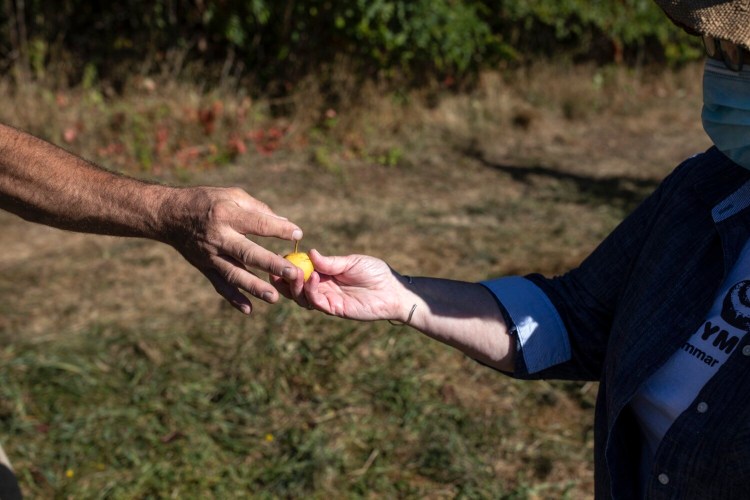There are three types of drought, state climatologist Sean Birkel told participants in an online panel discussion that was part of the Maine Agricultural Trade Show in January. Last year, Maine had all three.
“May to September might be most impactful drought on record for that short period of time,” he said, noting that Bangor went 31 days without getting any rain at all.
The three types of drought are: meteorological, which is based mostly on how much precipitation has fallen; agricultural, which adds evaporation into the calculation and shows the impact on growing crops; and hydrological, which includes groundwater in aquifers.
The worst drought in Maine’s recorded history occurred between 1964 and 1966, Birkel said, which surprised me, because of the reputation of the drought of 1947. But an article on the website of the New England Historical Society backed up Birkel: “Maine (in 1965) was drier than in 1947, when fires destroyed nine communities and a quarter million parched acres.”
Obviously, last year’s drought affected farmers. In three of the past five years, Maine farmers have had a loss in yield caused by drought, Rachel Schattman, assistant professor of sustainable agriculture at the University of Maine, told those attending the panel discussion. Such was definitely the case last year.
Fortunately, from October to December last year, rainfall was above normal, and groundwater levels had returned to normal, Birkel noted. But this winter has been mild, with little snow.
As interesting as those weather statistics are, what matters – to me, at least – is the future. What will this year’s growing season be like? And how should home gardeners – the Ag show talk focused on commercial farmers, but obviously the weather affects all of us – deal with it?
Unless you own a crystal ball, there is no way to predict the character of the 2021 growing season. Despite the recent drought years, Maine has, overall, been wetter and warmer than in past recorded conditions, especially during the decade ending in 2016. The rain often comes in heavier but less frequent rainstorms, a cycle that is tied to climate change.

Home gardeners can store rain from periods of heavy rain in rain barrels for a ready (free) supply when the weather turns dry. Very heavy rains and long periods of drought are becoming more common in Maine. Gregory Rec/Staff Photographer
Schattman said that many farmers deal with the increasing number of dry spells by creating new farm ponds or digging new wells – both of which store water from heavy rains for use when the weather gets dry. Home gardeners can apply the same principle on a smaller scale by installing additional rain barrels. We have four at our house, and even though they were empty for several weeks last summer because of the lack of rain, using them helped us to use less municipal water.
The other thing growers can control is how they handle their soil. John Jemison, a UMaine agriculture professor and a panelist, said that he learned early on that bare ground is bad; with nothing between the soil and the warm, dry air, the moisture from the soil evaporates more quickly than if plants or mulch cover the soil. Tilling speeds the drying process further. Historically, when farmers spread manure on their fields, they tilled it in. But research has shown that the crops do better if the manure is left on the top, and that the benefits of the manure can penetrate without tilling. A bonus, Jemison said, is that by skipping the step of tilling, farmers save time and fuel.
Cover crops are also helpful, whether they are grasses, such as rye and oats, or root crops, such as radishes. And, it was noted, even if the geese eat the tops of the radishes, they provide benefits as it’s the roots that provide the big advantage.
At the time of the Ag Show, the ground in most of southern Maine had little or no snow cover but the speakers said it was too early to tell how that would affect the 2021 growing season. In the weeks since, we’ve had some snow and a bit of snow pack – which should help the aquifers.
So, assuming we will have some dry periods this summer as seems to have become more usual, what do I plan to do?
I probably will move more toward the no-till style in the vegetable garden. We don’t spread manure, but we do use other organic fertilizer, which I think would work well without tilling. Each year I spread leaf mold (the previous year’s raked leaves) on the garden after we have harvested, mid-July for peas, for example. Usually, I turn those in with my broad fork in the spring. This year I will skip that step; instead I’ll just pull the leaf mold back in order to plant seeds.
And I might spend some time figuring out where I can put a fifth rain barrel.
Tom Atwell is a freelance writer gardening in Cape Elizabeth. He can be contacted at: tomatwell@me.com.
Send questions/comments to the editors.



Comments are no longer available on this story